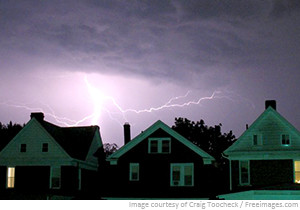
July and August are the most dangerous months for lightning strikes in the United States. According to the Insurance Information Institute (I.I.I.), lightning strikes caused $739 million in homeowner insurance losses in 2014, up 9.7 percent from 2013. Florida had more homeowner insurance claims for lightning losses in 2014 than any other state, followed by Georgia and Texas.
Fire investigators have known for well over a decade that when lightning strikes a home built with corrugated stainless steel tubing (CSST), fires often occur. Electrical arcs melt holes in gas lines, allowing gas to leak; in the presence of an arc, fires result. A previous blog post discussed the potential fire risks associated with CSST.
It only takes one lightning strike to create a catastrophic loss for a homeowner or business. An independent fire forensic fire investigation is necessary to establish the origin and cause of a fire, even when lightning is suspected. Here are a few facts to consider regarding fires caused by lightning:
- Gas lines that come in contact with metal components used in building construction—such as metal flues, copper pipes and heating, ventilation and air conditioning (HVAC) systems—are more susceptible to fire because lightning current can transfer between the CSST and the adjacent metal. Fire investigators and fire protection engineers can analyze construction elements to assess code and building compliance standards, which can support subrogation and litigation.
- Since CSST is often installed in walls, below floors and in attic spaces, a fire can burn unnoticed until other building components ignite, resulting in a much larger and more damaging fire. Fire modeling can determine whether what was reported for a fire scenario could actually have happened. Forensic fire protection engineers can use models to predict the effects of a fire scenario, present the results using a three-dimensional graphical model, and demonstrate what occurred. Engineers can also evaluate the models of opposing parties in the event of legal dispute.
- Non-residential properties like offices, industrial/manufacturing facilities and other business properties are also subject to significant fire damage from lightning strikes. According to the I.I.I., these fires caused an annual average of $108 million in direct property damage between 2007 and 2011. Damage to a business property is compounded by the loss of revenue that results from having to shut down operations. Fire investigators and forensic engineers can inspect buildings and facilities to confirm that building codes and associated requirements are met. Specifically, engineers can assess installed fire suppression systems, fire detection systems and passive fire protection systems, such as fire walls, fire barriers, fire doors and fire resistance rated construction. These measures can significantly reduce losses in the event of a lightning strike.
Fire investigators and forensic fire protection engineers are experts in assessing all types of fires, whether natural or man-made, and aim to make things right for home and business owners. While it is impossible to prevent lightning strikes, you can rest a little easier knowing there are experts who can help with loss recovery when disaster strikes or assess your existing property to identify any potential existing hazards.
Please feel free to share your ideas and questions with us; the Unified Investigation & Sciences team is here to meet the needs of your organization.
Michael Reynolds, IAAI-CFI, FCLS | Director of Total Performance
Unified Investigations & Sciences, Inc., a Sedgwick company